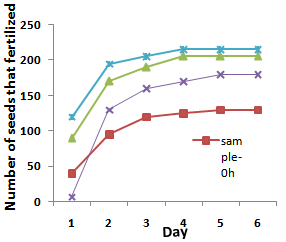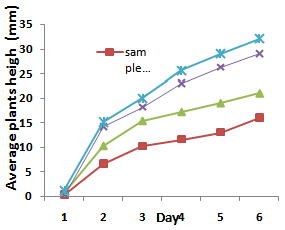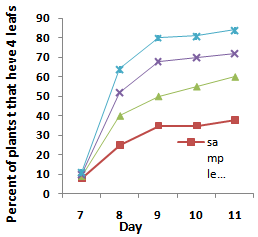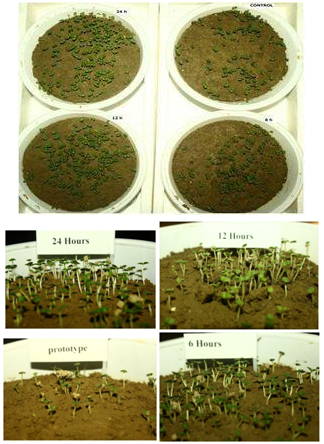-
Paper Information
- Paper Submission
-
Journal Information
- About This Journal
- Editorial Board
- Current Issue
- Archive
- Author Guidelines
- Contact Us
International Journal of Plant Research
p-ISSN: 2163-2596 e-ISSN: 2163-260X
2012; 2(4): 108-110
doi:10.5923/j.plant,20120204.02
The Influence of LED Light on Basil Seeds before Sowing and its Effects on Growing and Germination
H.R. Behzadi1, M. Qaryan2, S. Shahi2
1University of Technology, Optics and laser Group, Isfahan, Iran
2Prato Pardazesh Espadan Institute, Isfahan, Iran
Correspondence to: H.R. Behzadi, University of Technology, Optics and laser Group, Isfahan, Iran.
| Email: |  |
Copyright © 2012 Scientific & Academic Publishing. All Rights Reserved.
The effects of LED light on plants after sowing are presented. In this research, we expose basil seeds with LED light before sowing them and we investigate influences on plant germination after sowing. Basil seeds were divided into four groups. First group was the control group and received no radiation. Second, third and fourth group were irradiated 6, 12, 24 hours ,respectively by the LED lamp with wavelength of 620-625 nm and 500-600 mcd from a distance of 1 cm. Exposure time was adjusted so that the end of exposure time was Simultaneity for all samples. Samples were implanted immediately after exposure. Control on samples showed that LED irradiate light on seeds before implantation increases the growth rate of this plant. Seeds that had been irradiated before implantation demonstrated more fertilization, better growth, average height and more uniformity.
Keywords: Basil, Germination, Growth, Led,Seed
Cite this paper: H.R. Behzadi, M. Qaryan, S. Shahi, The Influence of LED Light on Basil Seeds before Sowing and its Effects on Growing and Germination, International Journal of Plant Research, Vol. 2 No. 4, 2012, pp. 108-110. doi: 10.5923/j.plant,20120204.02.
Article Outline
1. Introduction
- Light is the major elements in growing of plant. The effect of light during plant growth and fertility process is undeniable. Before the invention of the laser, light effects on plants and seeds before sowing and examine the effects of this radiation during plant growth did not receive much attention. Laser can emit a high density of photons at small solid angle. The amazing characteristics of the laser radiation, such as monochromatism, polarization, coherence and high density, can be used not only in all spheres of engineering but also in biology and plant growing[2]. The experiments carried out by the Institute of physiology in 1980 and later as well as by agrobiologists from Italy, Hungary and other countries, including Bulgaria show thatnon-photosynthesizing cells and material are capable of accumulating sunlight energy[2].Regarding to the available published data, a few papers were published about the use of laser on medicinal plants[1]. The previous studies showed that He-Ne lasers and Co2 lasers (continuous wave) presented a positive role in acceleration the plant growth and metabolism[3-6], wich suitable applications of laser irradiation improvedgermination capacity of plant seeds[7]. Generally, in these types of applications, researchers used He-Ne or laser diode with wavelengths of between 600 and 700 nm[11, 13]. They use He-Ne laser that emits a fractional of milli- watts to tens of milli-watts of red light at 632.8 nanometer[1]. Before implantation, dry or wet seeds were irradiated at a specified time by laser. Increases in number of branches/plant in both dry and wet cases of exposure were noticed and also increase number of umbels/plant in both cases[1]. Laser irradiation on seeds can increase growth rate, product, roots, height and etc. one of the hypothesis that explains this process, use photon light feature. This hypothesis explains that photons light were stored in seeds and plants use this storage during the growth process. The changes that occur in the physiological state of seeds and plants can stimulate and inhibit their development and depend closely on the laser radiation type, its wavelength and intensity[2].Basil is a medical plant that pharmaceutics factory use seeds and leaves it to make drug. Also, this plant is in the vegetable group. Seeds of this plant are black and have half to two millimeters length and in this research use as a based seed that radiated by light emitting diodes (LEDs). The differences between old lamp and LED are low consumption, greater convergence of light in one direction, there are different colors and hence the different wavelength. With progress in semiconductor technology, manufacture can make LEDs with smaller divergence angle and moreradiation power. This article examined the effectiveness of red light of LED on basil seed and results during the growth process. Also, the effect of radiation on the duration of seed growth has been investigated.
2. Materials and Methods
- Total 4000 basil seeds were used in this experiment. Selected seeds were divided into four major groups with 1000 seeds. The first group received no radiation and divided to four groups of 250 seeds and each group sowed in separate pots. Group II, irradiated with red LEDs for 6 hours from a distance of 1 cm and then divided into four groups with 250 seeds and were sowed. The third and fourth groups were irradiated 12 and 24 hours with same light, respectively. Finally, they were sowed in separate pots as groups of 6 hours. This division is listed in the following summary:- Dry seeds without being exposed to radiation (control)- Dry seeds were exposed to 6 hours- Dry seeds were exposed to 12 hours- Dry seeds were exposed to 24 hoursThe exposure time was adjusted so that finish exposure time was same for all groups. The samples simultaneously were planted in the Pots which were kept in an environment by the average temperature between 20 to 25 degrees. After 50 hours, the first signs of growing were seen and following parameters were controlled on them:- Average number of fertilized seeds in each group- Average height of plants in each group- Average number of new leaves in plants- Growth rate of groups- Uniformity of growth in each group
3.Results and Discussion
3.1. Quantitative Results
- Fertilized seeds: The first fertilized seeds were seen in pots that received 24h LEDs light radiation. During 6 days after sowing time, the number of fertilized seeds was controlled per day. However, the number of fertilized plants was fixed after seven days of planting. Figure 1 illustrates fertilized seeds in each group after seven days.
 | Figure 1. The number of fertilized seeds per 6 days |
 | Figure 2. The Average plant height |
 | Figure 3. Percent of plants that have new leaf per day |
3.2. Qualitative Results
- Daily reports and observations during the seeds growing demonstrate some results that the sample 24 hours has more uniformity and other characteristics of growth better than others and plants height was close to average height. The samples with more radiation have more uniform growth characteristics. Furthermore, the Sample 24h have more greener leafs, which show that the amount of chlorophyll be greater in plants with more irradiation. After 45 days of planting date, the plant density and leaf width in 24h group were much higher than other samples. Samples that exposure with LED light had longer and more roots. For stability demonstration of results, the experiment repeated in 5 stages that all of stages presented similar results as shown in figures 4.
 | Figure 4. The comparison of growing process of radiated seeds by LED with different times |
4. Conclusions
- LED Light on basil seeds before sowing induced plant growth density parameters. Increasing of the internal energy on seeds with photons of LED light and change increasing growth rate, chlorophyll content, fertility, biological parameters are demonstrated. For small seeds, the LED lamp is more economical instrument and more easier than lasers before sowing. This treatment can increase quality and density of similar seed productions in short time durations.
 Abstract
Abstract Reference
Reference Full-Text PDF
Full-Text PDF Full-text HTML
Full-text HTML